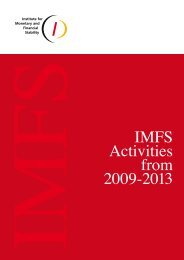ar2013
ar2013
ar2013
You also want an ePaper? Increase the reach of your titles
YUMPU automatically turns print PDFs into web optimized ePapers that Google loves.
Economic and Financial Environment<br />
Balance sheet trends<br />
Total loans and advances of retail banks grew by 14.6% in<br />
2013, while total deposits rose by 11.7%. As a result, the<br />
overall loan-to-deposit ratio of retail banks increased to<br />
56.3% from 54.8% in 2012. The Hong Kong dollar loanto-deposit<br />
ratio also rose to 74.8% from 72.3% a year ago<br />
(Chart 13).<br />
For the banking sector as a whole, credit growth<br />
accelerated from 9.6% in 2012 to 16.0% in 2013. The rate<br />
of growth in trade financing and loans for use outside<br />
Hong Kong continued to outpace that for loans for use in<br />
Hong Kong. The increase in loans for use in Hong Kong<br />
was mainly led by property lending, lending to wholesale<br />
and retail sectors and financial concerns. In view of the<br />
high credit growth in the banking sector in the first three<br />
quarters of 2013 (19.9% on an annualised basis), the HKMA<br />
wrote to banks with rapid loan growth informing them of<br />
the Stable Funding Requirement to be implemented in<br />
2014. Credit growth slowed in the fourth quarter (3.6% on<br />
an annualised basis).<br />
Retail banks’ total non-bank Mainland exposures 1 rose<br />
to $2,279 billion at the end of 2013 from $1,779 billion a<br />
year ago. For the banking sector as a whole, non-bank<br />
Mainland exposures increased to $3,602 billion from<br />
$2,739 billion in 2012.<br />
Holdings of negotiable debt securities<br />
Retail banks’ holdings of negotiable debt instruments<br />
(NDIs), excluding negotiable certificates of deposit,<br />
increased by 17.5% in 2013. The share of total holdings of<br />
NDIs relative to total assets rose to 25% at the end of the<br />
year from 24% at the end of 2012. Among the holdings of<br />
NDIs, 43% were government-issued (49% in 2012), 28%<br />
were issued by non-bank corporates (29% in 2012), and<br />
29% were issued by banks (22% in 2012) (Chart 14).<br />
Capital adequacy and liquidity<br />
All locally incorporated AIs remained well capitalised.<br />
The consolidated capital adequacy ratio of all locally<br />
incorporated AIs rose to 15.9% at the end of 2013 from<br />
15.7% a year earlier (Chart 15). The increase was due to<br />
faster growth in the capital base than in the risk-weighted<br />
amount. The Tier-1 capital adequacy ratio remained<br />
unchanged at 13.3% in the same period.<br />
Chart 13<br />
Retail banks’ Hong Kong dollar loans and deposits<br />
4,500<br />
$ billion<br />
%<br />
80<br />
4,000<br />
70<br />
3,500<br />
60<br />
3,000<br />
50<br />
2,500<br />
2,000<br />
40<br />
1,500<br />
30<br />
1,000<br />
20<br />
500<br />
10<br />
0<br />
0<br />
Dec 2008 Dec 2009 Dec 2010 Dec 2011 Dec 2012 Dec 2013<br />
HK dollar deposits<br />
(Left-hand scale)<br />
HK dollar loans<br />
(Left-hand scale)<br />
HK dollar loan-to-deposit ratio<br />
(Right-hand scale)<br />
1 Including exposures booked in retail banks’ banking subsidiaries in<br />
Mainland China.<br />
Page 42<br />
ANNUAL REPORT 2013 • HONG KONG MONETARY AUTHORITY



